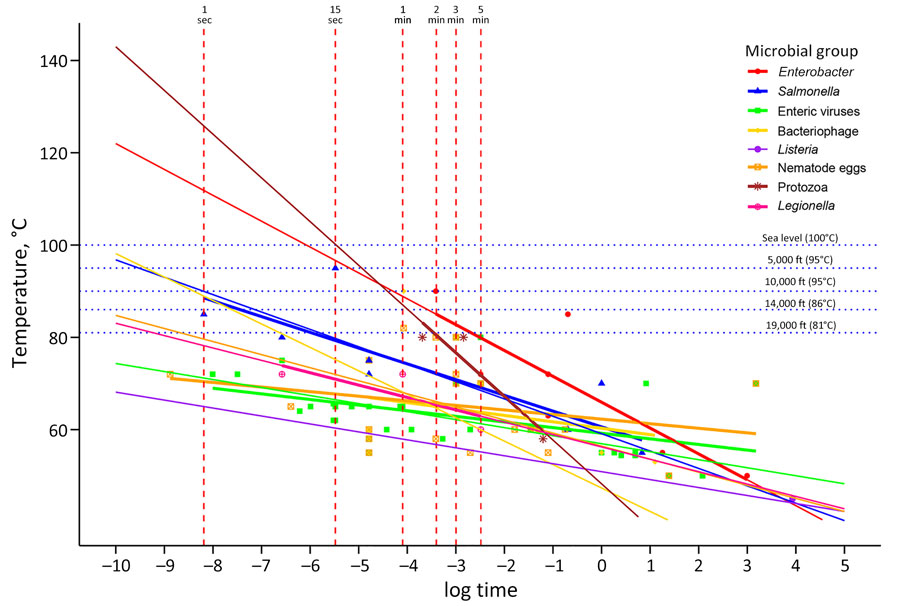Volume 31, Number 8—August 2025
Dispatch
Variance among Public Health Agencies’ Boil Water Guidance
Figure

Figure. Linear model of boiling time required to reduce pathogen levels, by elevation, for study of variance among public health agencies’ boil water guidance. Model estimates time to achieve 3–5 log reductions of specified microbial groups (3,11). At boiling point temperatures, all listed pathogens achieve the reductions in ≤1 minute, from sea level to 10,000 feet. Incorporating more data points at boiling or near-boiling temperatures could enhance accuracy. Models using pathogen-specific log reduction targets may provide more precise time estimates.
References
- State of North Carolina Office of State and Budget Management. Hurricane Helene damage needs assessment: Hurricane Helene recovery recommendations. December 13, 2024. [cited 2024 Dec 11]. https://www.osbm.nc.gov/hurricane-helene-dna/open
- Phillis MAJ, Peterson B. A week after Helene hit, thousands still without water struggle to find enough [cited 2024 Dec 11]. https://apnews.com/article/hurricane-helene-asheville-north-carolina-water-737bd51b1351315dc28522e36c425f18
- Espinosa MF, Sancho AN, Mendoza LM, Mota CR, Verbyla ME. Systematic review and meta-analysis of time-temperature pathogen inactivation. Int J Hyg Environ Health. 2020;230:
113595 . DOIPubMedGoogle Scholar - Centers for Disease Control and Prevention, US Environmental Protection Agency, American Water Works Association, Association of State and Territorial Health Officials, Association of State Drinking Water Administrators, National Environmental Health Association. Drinking water advisory communication toolbox. Updated 2016 [cited 2024 Dec 9] https://www.cdc.gov/water-emergency/media/pdfs/2024/08/dwact-2016.pdf
- Centers for Disease Control and Prevention. Drinking water advisories: an overview. [cited 2024 Dec 9]. https://www.cdc.gov/water-emergency/about/drinking-water-advisories-an-overview.html
- Backer H, Hill V. Water disinfection. 2023. In: CDC Yellow Book 2024: health information for international travel [cited 2024 Dec 9]. https://wwwnc.cdc.gov/travel/yellowbook/2024/preparing/water-disinfection
- US Environmental Protection Agency. Emergency disinfection of drinking water [cited 2024 Dec 9]. https://www.epa.gov/ground-water-and-drinking-water/emergency-disinfection-drinking-water
- Health Canada. Guidance for issuing and rescinding boil water advisories in Canadian drinking water supplies. 2015 [cited 2024 Dec 9]. https://www.canada.ca/en/health-canada/services/publications/healthy-living/guidance-issuing-rescinding-boil-water-advisories-canadian-drinking-water-supplies.html
- World Health Organization. Guidelines for drinking-water quality: 4th edition, incorporating the 1st addendum. 2017 [cited 2024 Dec 9]. https://www.who.int/publications/i/item/9789241549950
- World Health Organization. Boil water. 2015 [cited 2024 Dec 11]. https://iris.who.int/handle/10665/155821
- Sharvelle S, Ashbolt N, Clerico E, Holquist R, Levernz H, Olivieri A. Risk-based framework for the development of public health guidance for decentralized non-potable water systems. Proc Water Environ Fed. 2017;8:3799–809. DOIGoogle Scholar
Page created: June 24, 2025
Page updated: July 22, 2025
Page reviewed: July 22, 2025
The conclusions, findings, and opinions expressed by authors contributing to this journal do not necessarily reflect the official position of the U.S. Department of Health and Human Services, the Public Health Service, the Centers for Disease Control and Prevention, or the authors' affiliated institutions. Use of trade names is for identification only and does not imply endorsement by any of the groups named above.